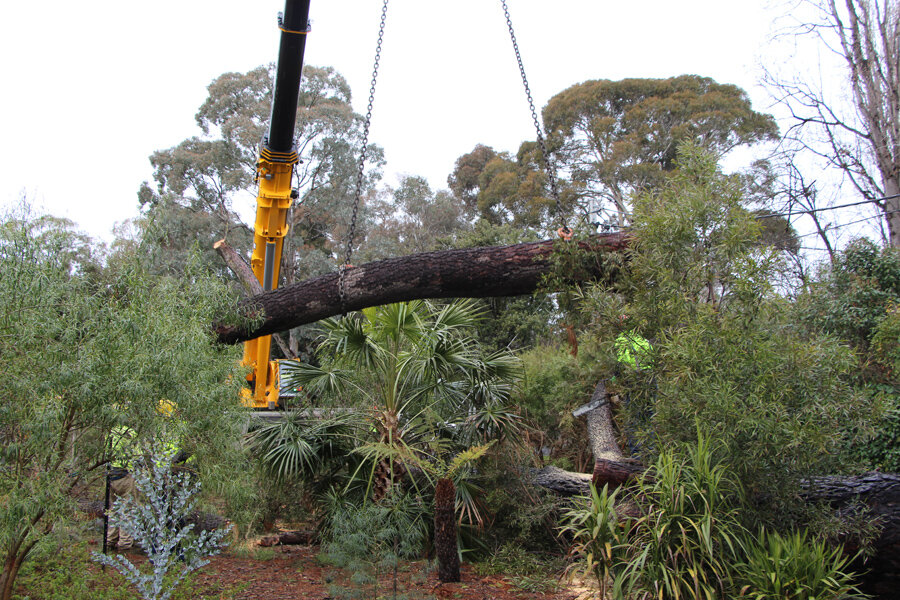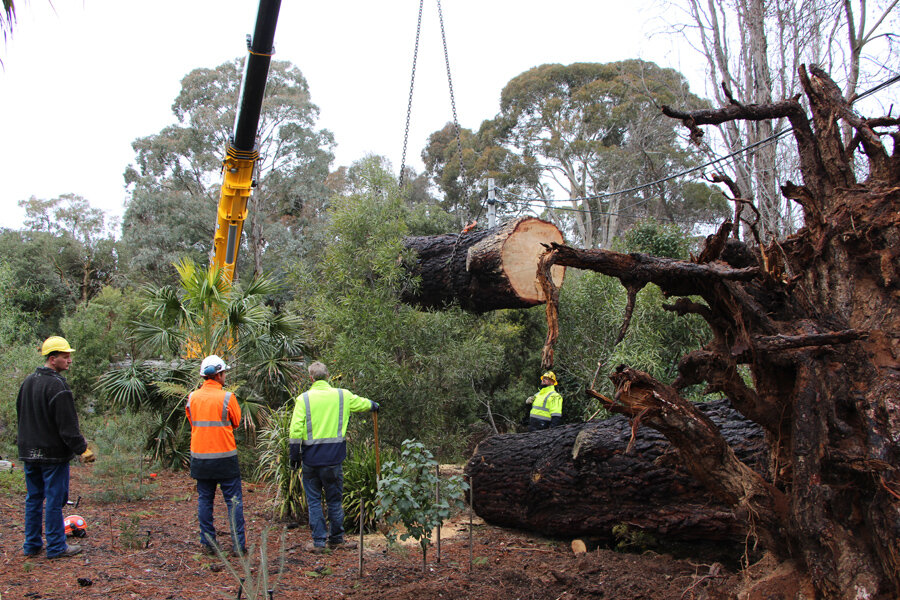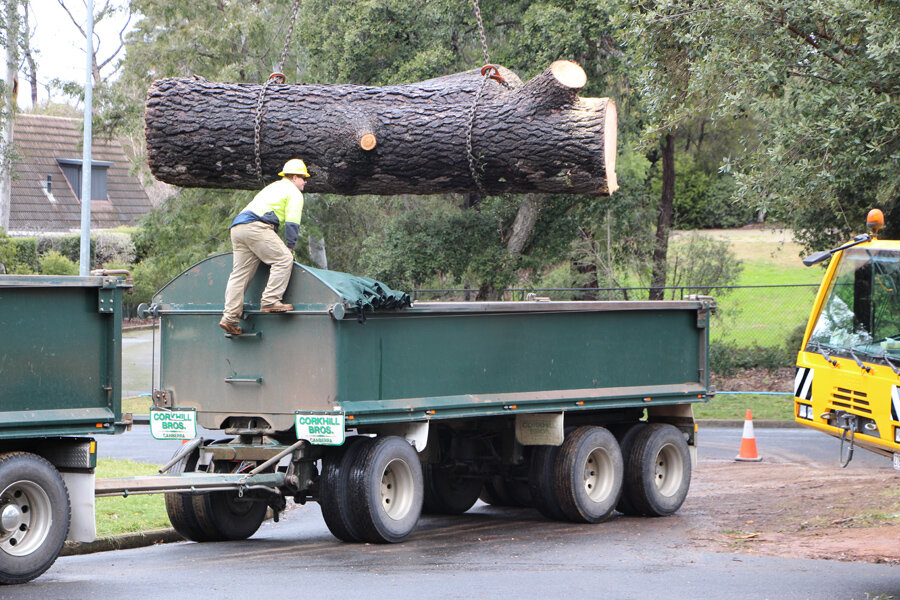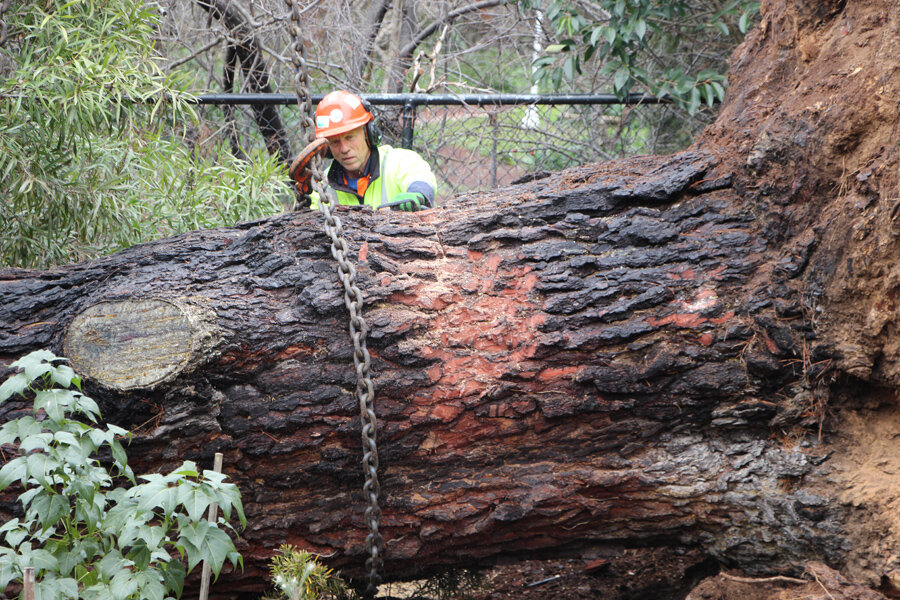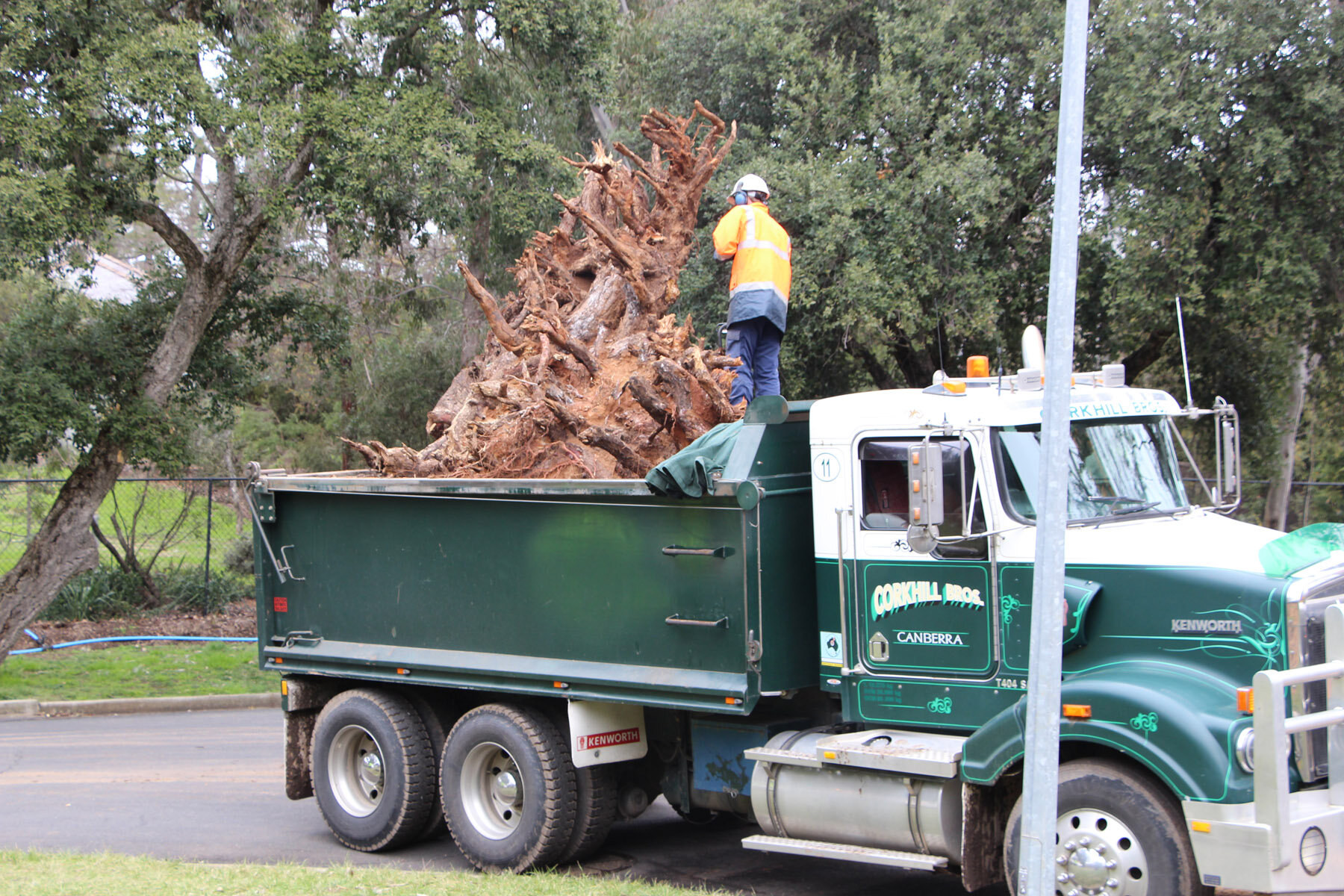When disaster strikes
On the night of Friday 22 July, 2016 or maybe the morning of Saturday 23 July, the last of our 85 year old pine trees (Pinus radiata) crashed to the ground. Over that night in Canberra we had wind gusts up to 80 k/hour and the ground was sodden from record rainfall. We had the wettest June ever recorded in the capital this year.
Lots of plants crushed
The venerable pine removed most of the plantings in the bottom right hand corner of the garden. It took out our collection of callistemons, now 13 years old, a large Casuarina cunninhamii of similar age, and our much beloved Silky Oak (Grevillea robusta). The ‘Canberra Bells’ correas that I talk about in the section on correas are now flattened, so are a group of Hakea eriantha. The well-established front hedge of Callistemon salignus and Callistemon ‘Firebrand’ will have to be resurrected in that section. We also lost our mature Golden Wattle (Acacia pycnantha) in another section of the garden.
However, as is always the case in disasters, many treasures were spared – a group of Cordyline stricta nursed along through the Canberra winters, a recent planting of Myoporum floribundum x batae, Brachychiton ‘Griffith Pink’, a large patch of Eremophila subfloccosa and several Calothamnus.
We have removed the old pine trees (at vast expense!) from around the boundary of our property over the last few years. They were senescing and dropping limbs, but we left one last pine which looked healthy and was a popular perch for our local birds. This tree also had a nest-box on it which had been used in past seasons. It is still in use, Ben discovered, by a ring-tailed possum, even after the demise of the tree. The possum does not mind that his home has gone massively down-market!
Myoporum floribundum x bateae
We must look on this area as an exciting opportunity to plant anew. I well remember the 1987 ‘Great Storm’ in England, the worst for over 300 years, which claimed many lives and felled over 15 million trees. I then admired the horticulturalists at Kew, while mourning their great trees, also managed to see it as a once-in-a-lifetime opportunity to plant afresh. Here, in microcosm, we have the same opportunity.
Second Disaster
Hailstorm 20 January 2020
Canberra suffered a violent hailstorm which cut much of the foliage on our plants to ribbons. The waterlilies, which were in bloom, were shredded into waterlily salad.
Third disaster
At midday, 29 November 2020, a windstorm brought down half of our Eucalyptus sideroxylon rosea planted in 2005 and a large branch from Eucalyptus globulus ssp. maidenii, planted in 2006 which damaged the upper sand garden considerably.
Frosty Winter of 2025
There are many enjoyable parts of a Canberra winter, sunny days and blue skies, but killing frosts in the garden are not welcome. This year we endured five nights in a row where the temperatures fell below minus 5 degrees between June 26-30. The last time this degree of frost occurred for this number of nights was in 1965, 60 years ago. We also recorded minus 7.6 degrees on Saturday, June 21 - the last time that it was colder than that in Canberra was in 1957. We have lost too many plants in the garden this winter, both well-established and newly planted. Our garden has numerous plants that could be considered experimental in our climate. We have been spoiled by mild winters over the last few years which have allowed these tender plants to make it through our winters, but the winter of 2025 proved to be their comeuppance. Our pot plants have also suffered, even though many of them were under cover, or in the shadehouse, and had survived our Canberra winters previously. We are not alone, as every Canberra gardener has a tale of woe.
Alyogyne huegelii ‘Eastcoast Gem’ Corymbia ’Summer Red’ Thomasia grandiflora
Below are plants that we have lost this winter:
Acacia inaquilatera – Kanji Bush, Baderi, Fire Wattle – planted May 2025 in a pot, in the shadehouse
Alyogyne huegelii ‘Eastcoast Gem’ – new planting under protection January 2025
Asplenium australasicum – Bird’s Nest Fern – planted in a pot in September 2023 – under protection, but very browned off, discarded August 2025
Brachychiton bidwillii – Little Kurrajong – planted in a pot in 2013, moved to garden January 2024, died September 2025
Calocephalus citreus – Lemon Beauty Heads – new planting January 2025, disappeared
Cassinia uncata – Sticky Cassinia – planted November 2023, disappeared
Coronidium ‘Sunny Side Up’ – planted under overhead cover, February 2025
Corymbia ’Summer Red’ – planted March 2024 in a pot and moved to the garden May 2025. This was quite an advanced specimen and our decision to move it to the garden this frosty year is regrettable.
Dampiera diversifolia ‘Southern Blue’ – planted in December 2021, but browned off completely this winter, despite being under cover, discarded in August 2025.
Eucalyptus conferruminata – Bald Island Marlock, Bushy Yate – planted in a pot, in the shadehouse December 2024, died August 2025
Eucalyptus globulus ssp. maidenii - Maiden’s Gum – planted October 2006, long established, 30m high, but now completely browned off and we have a permit to remove this tree
Grevillea ‘Lemon Daze’ planted September 2019, died
Hakea platysperma – Cricket Ball Hakea – listed as hardy, planted in a pot February 2025, discarded in August 2025
Hibiscus heterophyllus pink - planted November 2019, in a pot, under cover, browned off and discarded
Hibiscus ‘Ian’s Gold’ - planted October 2021, in a pot, under cover – moved to garden January 2024 – bad timing, died
Melaleuca diosmifolia – planted August 2022, browned off and died 10/25
Thryptomene sp. ‘Lancelin’ – planted in a pot, under cover, in March 2025, but looks poorly in September 2025 – died
Thomasia grandiflora – planted May 2022, well established, but we lost the Banksia that protected this plant, died
Xeronidium ‘Unity’ – planted February 2025, all three plants died
Hardenbergia violacea ‘Meema’ Leptospermum ‘Pageant’ Hibiscus ‘Aussie Delight’: new shoots
We also have many plants that are badly burned by frost which may or may not survive listed below. You do have to be very patient in spring and look carefully for signs of life under the depressing brown foliage. Syzygium australe has been blasted by the frost again this winter, but it has always come back from complete disaster – fingers crossed. I find that some plants come through the winter looking green and hopeful then often die at the very end of winter in the last week of August. They look fine until they don’t. Below are plants that are struggling in October 2025.
Blechnum medium (was Doodia media) - planted, under overhead protection, October 2020
Blechnum neohollandicum (was Doodia aspera) - planted, under protection, October 2020
Gossypium ‘Flirtatious’ – planted in a pot November 2020, long established, but completely browned off, leafless, but still showing green when scratched in September and very slowly starting to leaf out in October
Hardenbergia violacea ‘Meema’ - three planted December 2022 on a warm wall – two are completely dead and the other survives
Hibiscus ‘Aussie Delight’ - planted March 2021, in a pot, under cover, browned off completely this winter, despite being under cover, but has recovered after a severe prune and is leafing out in October
Hibiscus geranioides - planted October 2015, in a pot, under cover, completely browned off, leafless, but still showing green when scratched in September, in October has leafed out and is flowering!
Leptospermum ‘Pageant’ – planted 2022, burned foliage, but has recovered and is flowering in October 2025
Paraserianthes lophantha – Cape Leeuwin Wattle or Plume Albizia Planted January 2021 – this plant looked in dire straits, but has now recovered and is flowering in October, tough cookie
Rhododendron lochiae - planted in a pot, under protection, in February 2020, but half of the plant is browned off
Syzygium australe planted December 2008, drops browned leaves every winter, but so far has resurrected itself every spring
Brachychiton bidwillii Syzygium australe
For those of you who do not have to worry about frost, it is worth remembering that it is essential for those of us who do to have correct frost information on our plant labels. ‘Frost tolerant’ means that you can sometimes get away with planting these species against a warm wall, in a warm spot, or under overhead foliage protection. But to plant with confidence in Canberra you need ‘frost hardy’ on the label. Many labels have no frost information at all.
First published in Journal, ANPS Canberra, September 2025. Updated October, 2025





